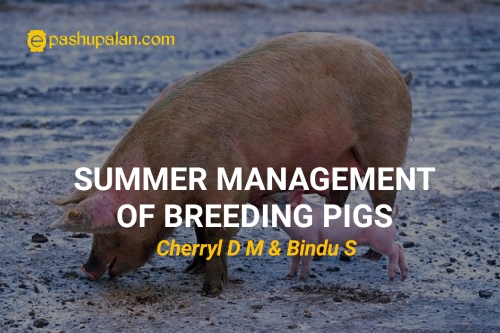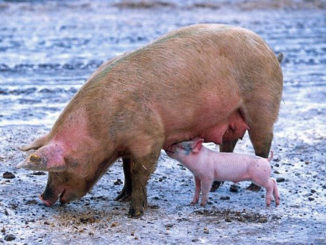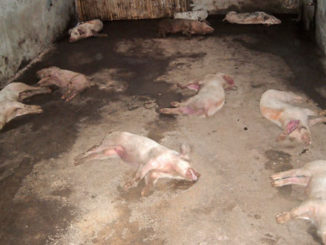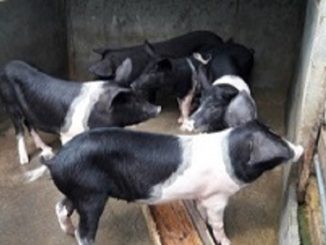The summer season presents additional challenges with regard to the management of finishing pigs. Under a wide range of situations and production systems heat stress can occur in all classes of pigs. When pigs are not properly managed, the hot weather tends to have adverse effects in relation to pig performance during its finishing stage. Finishing pigs may exhibit stress at approximately 70°F and an increase of respiration rate of finishing pigs may start at 72°F. In addition, temperatures above 85°F will have an impact on animal performance and the welfare of finishing pigs.

To provide comfort and to minimise the stress during the rearing of pigs the following general points are to be considered:
Pig handling: Extra attention should be provided for the movement of pigs. Pigs should be maintained calm, moved slowly and refrain using electric pods. The handler should also be sure to avoid loud noises, and consider moving pigs slow. Moving pigs into too large groups also makes pigs more excitable and hot. Finally, try to avoid excessive stationary periods when moving, loading, and transporting swine, particularly in hot weather conditions. Pigs should be handled and transported early in the day or late in the evening when it is cooler. Heat will increase the stress on an animal during movement. Open mouth breathing, vocalization (squealing), blotchy skin, stiffness, muscle tremors, increased heart rate, and body temperature are signs of pig stress.
Provision for adequate, clean water: Water usage will increase for each type of animal during summer. Nipple waterers should be checked for minimum flow rates to ensure animals are able to meet their minimum requirements for water. The flow should be 1 to 11⁄2 cups per minute in the younger pigs, while the flow rate should be at least 3 to 4 cups per minute in the finisher.
Prevent overcrowding: In summer, overcrowding of pigs will have a bigger impact. In warmer weather, adequate space should be provided for reducing conflicts and thus improves the pig performance.
Check and maintain ventilation: It is important to check fans, cool cell pads, drip-and-spray cooling systems and air inlets to ensure they are functional. The first step towards reducing the impact of heat stress on sow fertility is to ensure that ventilation systems are in good working order and adequate ventilation is provided. Unless required ventilation is not provided any sophisticated management practice that will be adopted will not be effective.
Pigs are more sensitive than humans to the combined effects of heat and relative humidity, since they don’t sweat. Generally speaking, if it is 75o F in the barn, but due to high humidity the heat index is above 85o F, then the supplementary cooling system needs to be active. These include evaporative drip, circulating fans and spray cooling. Sprinkling is preferred than fogging, as it uses smaller water droplets. Sprinkling cools the surface of the skin by wetting the skin and allowing the water to evaporate, while fogging cools the air and then the skin needs to cool down by air. The installation of nose coolers may be another effective method for cooling the sows during lactation.
Care when trucking: When trucking animals, loading and unloading the animals should be done promptly and do not unnecessary stops. Animals should be wet prior to transport on hot days. Trucks should provide maximum ventilation, and it may be beneficial to use wet sand or wet wood shavings for bedding.
Care of breeding herd: Seasonal infertility is well documented in swine. If the herd has a seasonal infertility history then proper precautions should be taken. This can be achieved by breeding up to 40 percent more females, depending on the drop in farrowing rate. Breeding targets should gradually increase through May, June, July and August and fall to a normal level through September. High temperatures reduce the intake of feed which impairs the ability of the female to recover adequately from farrowing. This results in longer wean-to-oestrus intervals and reduced ovulation rates.
Remember that it is just as important to keep the boars fertile as to keep the sows in the herd at ease. Two weeks of exposure to temperatures of 80-degree-plus Fahrenheit causes a dramatic increase in abnormal sperm and a reduction in motility. Recover from heat stress will take the boar a minimum of four weeks. Boars can also become lethargic, and reduce libido during hot weather periods. Temperatures that are greater than 85 degrees may reduce semen quality for 4 to 6 weeks, hence when temperatures rise, monitor the boars’ respiration rates. Normal respiration is 25 to 35 breaths per minute, and during heat stress it increases to 75 to 100 breaths per minute. When the respiration of the boars reaches 40 to 50 breaths per minute, intervene to cool the boars and take measures.
Care during feeding: Care should be taken to keep sows consuming feed or at least avoid from decreasing during the summer months. This is the most critical step to reduce the impact of heat stress and seasonal infertility.
- Feed when temperatures are lowest: Feeding in the early morning or evening when temperatures are lowest can stimulate the sow’s appetite. A change in work schedule is often needed to accomplish this.
- Increase feeding frequency: Most producers experience an increase in feed intake of 10 to 15 per cent when they change from 2 to 3 times a day. The main thing to remember here is that each time you increase the feeding frequency you decrease the amount you feed. This could therefore be very important for sows whose body temperature can be at the upper end of the thermo-neutral range due to elevated ambient temperatures.
- Use fresh feed: Feed is more likely to spoil in warm conditions compared with cool conditions, especially when it contains high levels of fat. The essential point is increasing the feeding frequency with feeding slightly smaller meals at each feeding which is actually an excellent way to keep feed fresh as well.
- Try liquid diets: This practice may be applied during lactation; however, due to the short period of time sows are actually in lactation, it may be more beneficial to acclimatize females during late gestation to this change in diet. Wet feeding, however, reduces the amount of time that feed can stay in the trough and hence fresh feed may be fed. Success may vary greatly between operations but it has been reported that this strategy will boost sow feed intakes as high as 15 percent.
- Add fat to the diet: Due to poor feed intake, many sows are unable to meet the lactation’s metabolic demands and revert to a negative energy balance. This factor is probably responsible for most of the reproductive disorders during periods of high temperatures. One way is to ensure sows consume enough energy, even if they eat a smaller amount of feed is by adding fat to the lactation diet. Additional fat (7 to 10 per cent animal or vegetable fat) will increase the feed’s dietary metabolic energy content. There are however two important considerations when it comes to adapting this practice. First, a diet with high amounts of fat will rancid faster than a traditional diet with 1 to 2 per cent fat. Sows will not eat rancid feed, and hence feeding smaller quantities should be a standard practice more often. Second, because sows consume less feed, it will also be necessary to boost the dietary levels of essential vitamins and minerals in order to account for less feed consumed daily.
- Provide constant water: High ambient temperatures, particularly for sows, will increase the water requirements. An effective mechanism by which pigs lose body heat is the increased water consumption coupled with an increased urinary water loss. Changing the ambient temperature from 54º-60º F to 86º-95º F gives water consumption an increase of >50 per cent. Nursing sows need to consume 30-35 litres of water each day, and sow 10-15 litres of water every day. One thumb rule is a 5:1 water to feed ratio. Also critical during breeding and gestation is fresh and constant water supply. When the flow rate is low, sows will quickly become frustrated, and that will influence their appetite for dry feed. Water temperature and quality of the water are important as well. Pigs will consume nearly double the amount of cool (50º F) water than warm (80º F) water during periods of high ambient temperatures.
Care to prevent prenatal mortality: Mortality can be as high as 40 per cent at this stage. During the first 2 to 3 weeks following breeding the embryo loss can be high. Factors associated with embryo loss include disease, stage of pregnancy, genetic factors, age of dam, nutrition, intrauterine environment, external environment and stress. During a critical time when pigs are under extreme heat stress, following practices are to be taken care
- Avoid late oestrous inseminations: The females must be bred on the idea of standing heat response only. In our own way to scale back mistimed inseminations is to work out the typical estrus length in your weaned sows, gilts, and repeat breeders and using these averages, shorten the last insemination interval. Never handle the sows/gilts unnecessarily.
- Once fertilization occurs within the oviducts, pig embryos descend into the uterus very quickly; however, implantation doesn’t occur until day 12 and full attachment until day 18. During this point, the pig is extremely vulnerable to stress factors, like movement and temperature. If females are to be mixed, this could be performed on the day of weaning to forestall unnecessary stress on the animal. Any unnecessary stress following breeding may end up in embryo detachment and loss.
- Refrain from, or maybe stop, moving females in gestation to different locations: After breeding and around day 30 of pregnancy, females are often moved to a special location; however, mixing sows and gilts any time during or following breeding greatly increases the probabilities of subsequent embryo mortality. Temperature changes are likely to elevate embryo mortality, and steps to forestall environmental extremes should be taken to avoid unnecessary stress during early pregnancy.
- Provide a decent, level plane of nutrition before, during, and after breeding. Pre-mating nutritional status appears to be a greater determinant of embryo numbers and survival than the post-mating diet in gilts. This strategy requires “flushing” gilts with an additional 1 to 2 kilograms of feed during the estrus cycle before mating. This could be attempted for sows additionally, although most post-weaned sows will voluntarily restrict their own feed intake. However, various studies have indicated that high feed intake during the primary 30 days following breeding may additionally have a negative impact on the embryo survival rates. Therefore, sows and gilts should be maintained on grade feed plane or at slightly above maintenance following breeding.
Hence overall care of breeding stock is essential for the successful and profitable pig farming. Utilizing the following pointers together with good husbandry can minimize the consequences of warmth stress on pigs and on herd performance.







Be the first to comment